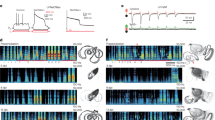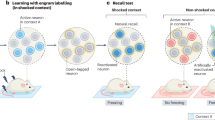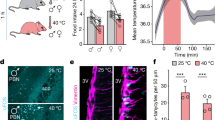Abstract
Memories are dynamic and can change when recalled. The process that returns memories to a labile state during remembering is unclear. We found that the presence of NMDA, but not AMPA, receptor antagonists in the amygdala prior to recall prevented the consolidated fear memory from returning to a labile state. These findings suggest that NMDA receptors in the amygdala are critical for transforming a memory from a fixed to a labile state.
This is a preview of subscription content, access via your institution
Access options
Subscribe to this journal
Receive 12 print issues and online access
$209.00 per year
only $17.42 per issue
Buy this article
- Purchase on Springer Link
- Instant access to full article PDF
Prices may be subject to local taxes which are calculated during checkout



Similar content being viewed by others
References
Dudai, Y. & Morris, R. in Brain, Perception, Memory. Advances in Cognitive Sciences (ed. Bolhius, J.) 149–162 (Oxford Univ. Press, Oxford, 2000).
Kandel, E.R. The molecular biology of memory storage: a dialogue between genes and synapses. Science 294, 1030–1038 (2001).
Nader, K., Schafe, G.E. & Le Doux, J.E. Fear memories require protein synthesis in the amygdala for reconsolidation after retrieval. Nature 406, 722–726 (2000).
Spear, N. Retrieval of memory in animals. Psychol. Rev. 80, 163–194 (1973).
Miserendino, M.J., Sananes, C.B., Melia, K.R. & Davis, M. Blocking of acquisition but not expression of conditioned fear-potentiated startle by NMDA antagonists in the amygdala. Nature 345, 716–718 (1990).
Rodrigues, S.M., Schafe, G.E. & LeDoux, J.E. Intra-amygdala blockade of the NR2B subunit of the NMDA receptor disrupts the acquisition but not the expression of fear conditioning. J. Neurosci. 21, 6889–6896 (2001).
Kim, M., Campeau, S., Falls, W.A. & Davis, M. Infusion of the non-NMDA receptor antagonist CNQX into the amygdala blocks the expression fear-potentiated startle. Behav. Neural Biol. 59, 5–8 (1993).
Walker, D.L. & Davis, M. The role of amygdala glutamate receptors in fear learning, fear-potentiated startle, and extinction. Pharmacol. Biochem. Behav. 71, 379–392 (2002).
Rodrigues, S.M., Schafe, G.E. & LeDoux, J.E. Intra-amygdala blockade of the NR2B subunit of the NMDA receptor disrupts the acquisition but not the expression of fear conditioning. J. Neurosci. 21, 6889–6896 (2001).
Suzuki, A. et al. Memory reconsolidation and extinction have distinct temporal and biochemical signatures. J. Neurosci. 24, 4787–4795 (2004).
Przybyslawski, J. & Sara, S.J. Reconsolidation of memory after its reactivation. Behav. Brain Res. 84, 241–246 (1997).
Acknowledgements
The authors thank N.S. Burghardt, S.A. Josselyn and P.W. Frankland for discussions and comments on the manuscript. This work was supported by grants to K.N. from the Natural Sciences and Engineering Research Council (Canada), EJLB Foundation, International Human Frontiers of Science, the Volkswagen Foundation, the Alfred P. Sloan Foundation, Canada Foundation for Innovation, and Canadian Institutes of Health Research.
Author information
Authors and Affiliations
Corresponding author
Ethics declarations
Competing interests
The authors declare no competing financial interests.
Supplementary information
Supplementary Fig. 1
Models of the induction of plasticity. (PDF 69 kb)
Supplementary Fig. 2
Schematic representation of cannula placements of animals included in the statistical analyses. (PDF 100 kb)
Supplementary Fig. 3
Examination of drug diffusion by dye spread. (PDF 1566 kb)
Supplementary Fig. 4
Immunohistochemical analysis of PTZ-induced Fos protein levels after anisomycin infusion. (PDF 592 kb)
Supplementary Fig. 5
Autoradiographic evaluation of protein synthesis inhibition after intra-LBA anisomycin infusion, showing greater inhibition in the target area (LBA) than the adjacent Ce nucleus. (PDF 855 kb)
Rights and permissions
About this article
Cite this article
Mamou, C., Gamache, K. & Nader, K. NMDA receptors are critical for unleashing consolidated auditory fear memories. Nat Neurosci 9, 1237–1239 (2006). https://doi.org/10.1038/nn1778
Received:
Accepted:
Published:
Issue Date:
DOI: https://doi.org/10.1038/nn1778
This article is cited by
-
Cellular mechanisms of contextual fear memory reconsolidation: Role of hippocampal SFKs, TrkB receptors and GluN2B-containing NMDA receptors
Psychopharmacology (2024)
-
Muscarinic receptor activation overrides boundary conditions on memory updating in a calcium/calmodulin-dependent manner
Neuropsychopharmacology (2023)
-
Modulation of methamphetamine memory reconsolidation by neural projection from basolateral amygdala to nucleus accumbens
Neuropsychopharmacology (2023)
-
Modulation of memory reconsolidation by adjacent novel tasks: timing defines the nature of change
Communications Biology (2023)
-
Long term structural and functional neural changes following a single infusion of Ketamine in PTSD
Neuropsychopharmacology (2023)



